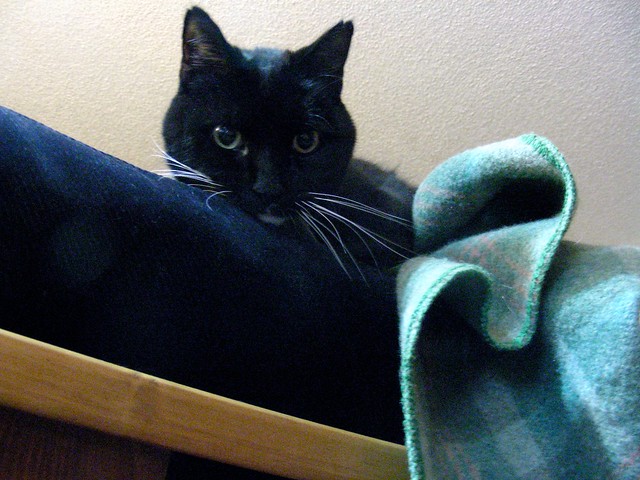Which is to say, Happy Kalevala Day!
I’d forgotten about it, but my friend Steve Facebooked me to ask, “Has Vainamoinen had a pleasant Kalevala day?” I answered, “He woke me up purring this morning.”
This is Väinämöinen. You can call him Vai.
But here’s the guy he was named after — the original Väinämöinen of the Kalevala, the Finnish national epic.

The painting, “Defense of the Sampo” is by the Finnish artist by Akseli Gallen-Kallela (1865–1931), and shows Väinämöinen fighting Louhi for possession of the Sampo, the magical object the smith Ilmarinen had forged for Louhi, which had brought untold wealth and prosperity to her land of Pohjola. The fight had mixed results — as summarized by the Finnish Literature Society (Poems 42–43):
Väinämöinen puts the people of Pohjola to sleep with his kantele playing and the Sampo is taken to the travellers’ boat and rowed away. The people of Pohjola awaken and Louhi, the mistress of Pohjola, sends obstacles in the path of the raiders to hinder their escape. The seafarers survive, but the kantele falls into the sea. Louhi sets off in pursuit and transforms herself into a giant bird of prey. In the ensuing battle the Sampo is smashed and falls into the sea. Some of the fragments remain in the sea, but others wash ashore and bring Finland good fortune and prosperity. Louhi is left with only the worthless lid of the Sampo and an impoverished land.
There was a lot more to Väinämöinen than Sampo-stealing. He was in part a god, in part a tietäjä — that is, a knower, what in English we’d call a shaman. In pre-Christian Finland, those were go-to people for healing and knowledge of the deep-down things. One of their chief tools was language — their charms and chants and poems — and Väinämöinen was the greatest of the singers. The Kalevala itself was compiled from oral poetry, passed down from mouth to mouth of largely illiterate but highly skilled singers, that was collected by folklorists in the first half of the 19th century, in particular Elias Lönnrot (1802–1884), whose foreword to the first edition of the Kalevala was signed on February 28, 1835. The Kalevala went on to play a crucial role in the development of Finnish as a language of literature and culture — in opposition to Swedish, which had been the language of elite in Finland for centuries — and was instrumental in the growth of a sense of Finnish national identity and nationalism, which culminated in Finland’s declaration of independence from Russia in 1917.
Väinämöinen is only one among several figures in the Kalevala that are personally important to me. But he’s the one who purrs in my ear nowadays.
Here’s more of my Väinämöinen the cat pics. Happy Kalevala Day!

